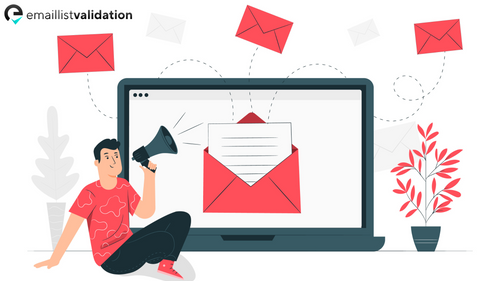Email verification is important because it helps businesses and organizations maintain a clean and engaged email list, minimize email bounce rates, increase deliverability and sender reputation, and comply with anti-spam laws and regulations. It also protects users against phishing and other online scams that rely on phony or compromised email addresses. This procedure guarantees that the email address is not a forgery, typo, or is no longer in use, hence avoiding unwanted bounce backs, spam complaints, and other concerns. And to ensure an effective email verification.
This article will enlist some of the current best practices for email verification that every email marketing campaign should consider following.
Verify email addresses at sign-up

Verifying email addresses at the point of sign-up is critical for preserving an online platform's integrity and security.
Here are some best practices for verifying email addresses at sign-up:
Email confirmation
Send an email to the user once they sign up, asking them to confirm their email address by clicking a verification link. This guarantees that the email address belongs to the individual who signed up and prohibits the creation of false accounts. Read more about the importance of testing email addresses.
Double Opt-In
Double opt-in is another efficient method for verifying email addresses. Send another email, in addition to the confirmation email, with a confirmation link that the user must click to complete the sign-up process. This strategy offers an extra degree of security and assures that the user is genuine in his or her desire to utilize the platform.
Error handling
Add correct error handling to guarantee that when people join up, they submit a valid email address format. Use a regular expression, for example, to validate email addresses and display a helpful error message if the user enters the wrong email format.
Timing and frequency
To avoid annoying users or sending them to spam folders, send the confirmation email and follow-up emails as soon as possible and at appropriate intervals.
By sticking to these best practices, you can ensure that your platform is secure, your user database is accurate and up to date, and you are effectively connecting with your users.
Use an email verification service

Email verification services are tools that help in the validation and verification of email addresses to ensure their accuracy and legitimacy. They work by examining the syntax of the email address, validating the domain name and email server, and doing many other tests to establish whether or not the email address is deliverable and active.
In order to choose the right verification service for your campaign, here are some things to consider doing:
- Research and contrast several email verification services to locate one that suits your individual requirements and budget.
- To achieve maximum accuracy, look for a service that provides various verification methods, such as syntax checking, domain verification, and mailbox verification.
- Examine the service's data privacy and security policies to guarantee that your information is safe and secure.
- To simplify the verification process, choose a service with an easy-to-use interface and simple integration choices. And for a faster process try to work with tools that provide bulk email address verification, if possible.
- Use the service on a frequent basis to guarantee that your email campaigns are accurate and deliverable.
- Keep track of and analyze the results of your email verification activities in order to find areas for improvement and optimize your email marketing approach.
To gain the greatest results, keep in mind that email verification is only one component of email marketing. It's also crucial to follow other best practices, such as avoiding spammy content and delivering relevant and targeted emails.
Implement email validation on input

Implementing email validation on input means validating the email address entered by the user in a web form or application. Email validation is often implemented by creating code that compares the input data to a set of rules or a regular expression that defines the standard email format. If the input value fits the rules or regular expression, the email address is valid, and the form submission can continue. If the user's input value does not meet the rules or regular expression, an error message indicating that the email address is invalid is displayed.
Overall, implementing email validation on input is an important step in guaranteeing accurate data collection, protecting security, and giving a great user experience.
Monitor Email Deliverability

Monitoring email deliverability is essential for adequate email verification since it helps you to track the effectiveness of your email campaigns and guarantee that your emails are reaching their intended recipients.
Here are some best practices for monitoring email deliverability:
Track bounces and complaints:
You should regularly monitor bounce rates and complaint rates to detect issues with email deliverability. High bounce and complaint rates can harm your sender's reputation and negatively impact email deliverability.
Use email authentication protocols
Use email authentication standards such as SPF, DKIM, and DMARC to ensure that your emails come from a reliable source. These measures contribute to the reduction of spam and spoofing and increase the likelihood of your emails getting delivered.
Maintain a clean email list
Clean up your email list regularly by removing inactive or incorrect email addresses, which might result in high bounce rates. A clean email list might help to enhance email deliverability and engagement rates.
Monitor deliverability metrics
Monitor critical deliverability indicators such as open rates, click-through rates, and conversion rates to determine the effectiveness of your email campaigns. These indicators can assist you in identifying issues with your email content, subject lines, or targeting that may be compromising deliverability.
Test and improve
Test your email marketing on a regular basis to see what works and what doesn't. To improve the deliverability of your email campaigns, use A/B testing to test different email content, subject lines, and sending times.
Conclusion
Email verification is the process of cleaning an email list by checking the validity of the email addresses on the list and providing a clean list ready to use. Keeping up with the current best practices for email verification listed above is vital for the success of your email marketing initiatives since they carry a direct impact on email delivery, sender reputation, and ultimately, ROI. Overall, a good email marketer won’t take these practices for granted.



